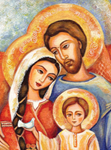Our Patron Saint – St Anthony of Padua
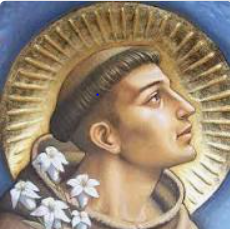 At St Anthony’s we ask our Patron Saint for his ongoing support with all aspects of school life, through our school prayer:
At St Anthony’s we ask our Patron Saint for his ongoing support with all aspects of school life, through our school prayer:
Dear Saint Anthony,
When I feel alone, help me find love.
When I’m depressed or in despair, help me find hope.
When I am angry, help me find a way to let go.
When I’m in trouble and I don’t know what to do, help me find God.
Help all here at St Anthony’s to follow in your ways. May our actions speak and our words teach so that we can live our faith and be an example to others,
Amen.
Class Saints
Each classroom has a class Saint which the children pray to each day. The children ask their class Saint to intercede for them each day at the end of prayers as they say “Saint xxx, pray for us.”
You may want to introduce this to family prayer at home. We remember our class Saint on their feast day (or near to it) and children learn about their Saint and present this to the school as part of their first class assembly.
Holy Family – Nursery
We remember the importance of the family unit, no matter what shape or size, as our youngest children look to their class Saints. Mary and Joseph were Jesus’ parents here on earth. Their story is one of challenge from the start, being refugees whilst having the responsibility of carrying God’s Son on earth. We celebrate their feast day on the Sunday after Christmas.
Saint Joseph – Reception
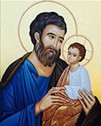 St Joseph was a humble man. He worked hard as a carpenter to provide for his family. St Joseph is the father of Jesus on earth.
St Joseph was a humble man. He worked hard as a carpenter to provide for his family. St Joseph is the father of Jesus on earth.
Joseph respected God and would always listen to what God wanted him to do. Joseph died before Jesus’ public life with Mary, and left the earth with Jesus by his side.
St Joseph is the patron of the universal church, carpenters and fathers. We celebrate his feast day on the 1st May.
Saint Francis of Assisi – Reception
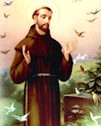 Saint Francis was born in 1182 and died in 1226 in Italy during a time of cultural renewal across Europe. His real name was Giovanni, but his father called him Francesco, or ‘the Frenchman.’
Saint Francis was born in 1182 and died in 1226 in Italy during a time of cultural renewal across Europe. His real name was Giovanni, but his father called him Francesco, or ‘the Frenchman.’
He was born into a wealthy family and enjoyed the lifestyle this gave him. During one of his rides he came across a leper and instead of staying away, he got off his horse and helped him. Francis was overjoyed, because the words the Lord had spoken to him had come true. Several days later, he made his way to the hospital for lepers outside Assisi, and calling them all together, he gave each one a gold coin, a kiss on the hand, and a kiss on the lips. Francis stayed there for several months, caring for the lepers by washing their bodies and treating them with kindness and respect.
Francis then went on to be the founder of the religious order known as the Franciscans. He became renowned for his love, simplicity, and practice of poverty and wildlife. We celebrate his feast day on October 4th.
Saint Veronica – Y1
 St. Veronica was a renowned legendary woman who, moved by the sight of Christ carrying his cross to Golgotha, gave him her kerchief to wipe his brow, after which he handed it back imprinted with the image of his face.
St. Veronica was a renowned legendary woman who, moved by the sight of Christ carrying his cross to Golgotha, gave him her kerchief to wipe his brow, after which he handed it back imprinted with the image of his face.
She is the patron saint of laundry workers and photographers.
We celebrate her feast day on 12th July.
St Martin de Porres – Y1/2
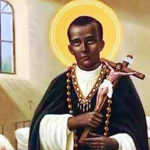 St Martin was known for his devotion to the Eucharist and constant prayer, and he refrained from eating meat as an act of austerity. He had great compassion for all people, regardless of their race or status, and his loving care extended to animals, including stray cats and dogs, beasts of the field, and even kitchen vermin.
St Martin was known for his devotion to the Eucharist and constant prayer, and he refrained from eating meat as an act of austerity. He had great compassion for all people, regardless of their race or status, and his loving care extended to animals, including stray cats and dogs, beasts of the field, and even kitchen vermin.
We celebrate his feast day on November 3rd.
St John Bosco – Y2
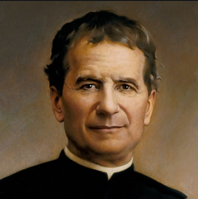 Bosco was ordained a priest (1841) in Turin and, influenced by St. Joseph Cafasso, began to work to alleviate the plight of boys who came to seek employment in the city. Working in borrowed premises, Bosco provided boys with education, religious instruction, and recreation; eventually he headed a large establishment containing a grammar school, a technical school, and a church, all built through his efforts.
Bosco was ordained a priest (1841) in Turin and, influenced by St. Joseph Cafasso, began to work to alleviate the plight of boys who came to seek employment in the city. Working in borrowed premises, Bosco provided boys with education, religious instruction, and recreation; eventually he headed a large establishment containing a grammar school, a technical school, and a church, all built through his efforts.
He founded the Society of St Francis de Sales and the Salesian Sisters of Don Bosco.
He was a very respected educator.
We celebrate his feast day on January 31st
St Patrick – Year 3
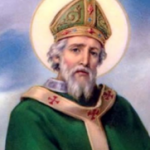 St Patrick is the patron saint of Ireland. Born in Roman Britain in the late 4th century, he was kidnapped at the age of 16 and taken to Ireland as a slave. He escaped but returned about 432 to convert the Irish to Christianity. By the time of his death on March 17, 461, he had established monasteries, churches, and schools.
St Patrick is the patron saint of Ireland. Born in Roman Britain in the late 4th century, he was kidnapped at the age of 16 and taken to Ireland as a slave. He escaped but returned about 432 to convert the Irish to Christianity. By the time of his death on March 17, 461, he had established monasteries, churches, and schools.
We celebrate his feast day on March 17th.
Saint Bernadette – Y3/4
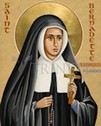 As a child, Our Blessed Mother appeared to Bernadette seventeen times and gave her a mission. Bernadette was asked to pray for sinners and build a chapel.
As a child, Our Blessed Mother appeared to Bernadette seventeen times and gave her a mission. Bernadette was asked to pray for sinners and build a chapel.
People did not believe that Our Lady had appeared to Bernadette and therefore she was locked away. Bernadette continued her journey in response to the mission that she was given, and set out to build a chapel. Bernadette found a spring of water which she used to heal people in the community, and as a result of her kind nature she became a nun.
Unfortunately, Bernadette died at a young age. We celebrate her feast day on April 16th.
Saint Mary Magdalene – Y4
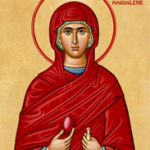 St. Mary Magdalene was a disciple of Jesus. According to the Gospel accounts, saved her from stoning and cleansed her of her sins. She was one of the witnesses of the Crucifixion and burial of Jesus and, famously, was the first person to see him after the Resurrection.
St. Mary Magdalene was a disciple of Jesus. According to the Gospel accounts, saved her from stoning and cleansed her of her sins. She was one of the witnesses of the Crucifixion and burial of Jesus and, famously, was the first person to see him after the Resurrection.
We celebrate her feast day on July 22nd.
Saint Maximilian Kolbe – Y5
 St Maximillian Kolbe sacrificed his life for a man who was captured by the Nazis.
St Maximillian Kolbe sacrificed his life for a man who was captured by the Nazis.
When Maximillian Kolbe was a child he had a dream that Mary appeared and said ‘Would you rather have a white or a red crown?’ The white one meant that he should persevere in purity and the red one meant that he should become a martyr. Maximillian Kolbe chose the red crown so he became a martyr.
Years after he died St. John Paul declared him a Saint of charity. His feast day is August 14th.
Saint Cecilia – Year 5
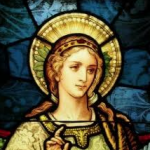 St Cecilia is the patroness of musicians and Church music because, as she was dying, she sang to God. It is also written that as the musicians played at her wedding she ‘sang in her heart to the Lord’. Her feast day is celebrated on November 22nd.
St Cecilia is the patroness of musicians and Church music because, as she was dying, she sang to God. It is also written that as the musicians played at her wedding she ‘sang in her heart to the Lord’. Her feast day is celebrated on November 22nd.
St Stephen – Year 6
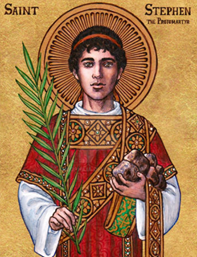 Saint Stephen was one of the first deacons of the Christian Church. He was the first Christian martyr.
Saint Stephen was one of the first deacons of the Christian Church. He was the first Christian martyr.
Stephen is believed to have been a Greek Jew who converted to Christianity. When the number of disciples increased, there was much confusion over the distribution of alms and the serving of the poor. Stephen’s trustworthy character marked him out, and he was chosen as one of the seven deacons who would perform this task. He was put to death for defending his faith.
Stephen is the patron saint of deacons, headaches, horses, coffin makers, and masons. He is often represented carrying a pile of rocks or with rocks on his head.
St Stephen’s Day is 26th December.

